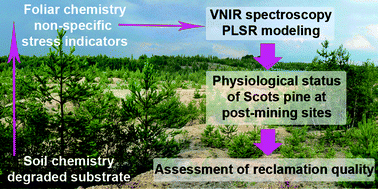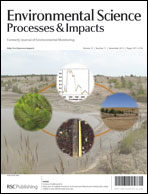Detection of multiple stresses in Scots pine growing at post-mining sites using visible to near-infrared spectroscopy†
Abstract
Heavy metal contamination, low pH and high substrate heterogeneity are multiple stress factors that often occur at the post-mining sites and make difficult the biological reclamation. Efficient tools for detection of the status of reclaimed vegetation at post-mining sites are needed. We tested the potential of visible to near-infrared (VNIR) spectroscopy to detect multiple stresses in Scots pine (Pinus sylvestris L.) at acidic substrates rich in As. The needle chemical traits (chlorophyll a + b – Cab; carotenoids – Car; Car/Cab; relative water content – RWC; soluble phenolics; lignin contents) were tested for sensitivity to different soil conditions of post-mining sites. For Scots pine growing on degraded substrates, at least three non-specific stress indicators (RWC, photosynthetic pigments and phenolics) are required to achieve good site separability corresponding to the stress load. We constructed and validated empirical models of selected needle chemical traits using VNIR spectroscopy: calibration of Cab (R2 = 0.97, RMSE = 0.17 mg g−1), RWC (R2 = 0.88, RMSE = 1.41 mg g−1), Car (R2 = 0.66, RMSE = 0.08 mg g−1), phenolics (R2 = 0.64, RMSE = 23.01 mg g−1) and lignin (R2 = 0.45, RMSE = 3.32 mg g−1). The reflectance data yielded comparable site separability with the separability calculated from the laboratory data. The presented approach has potential for large-scale monitoring of Scots pine status, thus, assessment of reclamation quality in post-mining regions using air-born or satellite hyperspectral data.


 Please wait while we load your content...
Please wait while we load your content...